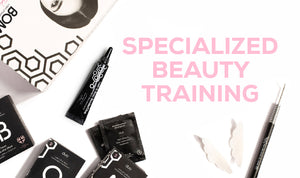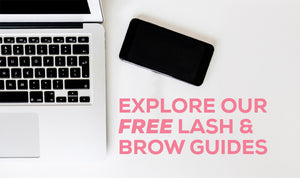Beautiful Brows & Lashes Blog
Brow Tint vs. Brow Henna: What’s the Difference?
You might have encountered information about brow henna while exploring options for your clients. But how does it compare to the brow tint you’re already used to?
Let us explain the basics of brow tint and brow henna, including their similarities and differences and when you might use them.
What Is Brow Tint?
Brow tint, or brow dye, works very similarly to hair dye and will ultimately add a tint of color to your client’s eyebrow hairs. Tinting is one of the most popular eyebrow services. It’s excellent for enhancing brows to make them darker and appear thicker and longer.
Suppose they already have a great shape, such as following a brow lamination, and want some added color. In that case, tinting can be a great option. The change that tint brings to the brow game is subtle but gives brows an improved and enhanced look.
You may have to use an activator for the color when applying the tint. After application, a brow tint generally lasts 2-6 weeks on the hair, depending on the products and the specific qualities of your client’s brows. The skin stain typically lasts only 1-2 days.

What Is Brow Henna?
Brow henna has a more permanent look and tends to be more dramatic. It stains the skin and the hair rather than just the hair. Henna can be helpful if you’re performing a brow lamination on a client with thin brows or many patchy areas that need filling in.
Beyond color, henna is a natural, plant-based product that nourishes and conditions the brows, promoting healthier hair growth. In contrast, brow tints are chemical-based and do not offer these benefits. Henna does not usually require chemical activation but often uses distilled water to activate. Because it stains the skin, henna lasts on the skin for 1-2 weeks and on the hair for maybe up to 8 weeks. This also makes it more noticeable.

Brow Tint vs. Brow Henna: Similarities
Both brow tint and brow henna are popular methods for defining your eyebrows. Here are a few ways in which they’re alike:
- Enhancement of brow color: Both brow tint and brow henna can help darken or lighten the natural color of brows, fill in sparse areas, and create a more polished and groomed appearance.
- Semi-permanent results: Both brow tint and brow henna provide semi-permanent results that last longer than traditional brow makeup like pencils or powders. They typically last for several weeks before gradually fading away.
- Quick application: The application process for a brow tint and brow henna is relatively fast and straightforward, making them convenient options for clients who want to update their look.
Brow Tint vs. Brow Henna: Key Differences
Brow tint and brow henna are different. Here are some of their significant differences.
Composition
Brow tint contains synthetic dyes or pigments that penetrate the hair shaft and deposit color onto the brows. In contrast, brow henna contains natural henna plant extracts, which are pigments that stain the skin and hair, providing a more temporary coloration.
Application Process
A technician applies brow tint directly to the eyebrows using a brush or applicator and leaves it to develop for a specific period before wiping it away. Brow henna, on the other hand, involves mixing the henna powder with water or another liquid to create a paste, which you then apply to the eyebrows and leave to dry before removing it. Henna requires a longer processing time and must be kept dry for at least 12 hours after application to ensure maximum longevity.
Longevity
Brow tint typically provides a more intense and longer-lasting color than brow henna. Tinted brows may last 4-6 weeks on the hair but only 1-2 days on the skin, whereas henna-stained brows usually last for 1-2 weeks on the skin and up to 8 weeks on the hair.
Color Options
Brow tints offer a more comprehensive range of colors, including black, gray, and shades of blonde and brown. Henna is limited to blacks, browns, and traditional henna red, which might restrict color customization.
Chemical Composition
Brow tint contains synthetic dyes or pigments that penetrate the hair shaft and deposit color onto the brows. In contrast, henna contains natural henna plant extracts, which are pigments that stain the skin and hair, providing a more temporary coloration.
Impact & Visibility
Henna provides a more dramatic and fuller look by staining the skin and the hair, making it ideal for those with sparse brows. In contrast, brow tints give a more natural appearance by only tinting the hair.
Hair Health Benefits
Beyond color, henna is a natural, plant-based product that nourishes and conditions the brows, promoting healthier hair growth. Meanwhile, brow tints are chemical-based and do not offer these same benefits.
Maintenance
Henna brows require careful aftercare, such as avoiding exfoliation to maintain the skin stain. Tinted brows are easier to maintain but can be affected by chlorine and frequent washing.
Suitability for Different Clients
Henna is especially suited for clients with sparse brows, those covering gray hairs, or those considering microblading. At the same time, tints are better for clients seeking a natural look or who already have fuller brows.
Natural vs. Semi-Permanent Makeup
Henna can serve as a temporary alternative for clients considering semi-permanent makeup like microblading, offering a preview of more defined brows without the commitment.
So, Which Is Better, Brow Tint or Brow Henna?
Whether you use tint or henna with your clients depends on their brow needs and what they want. You can even use tint and follow up with henna several days later. However, this is not always an option, so discuss your client’s goals and expectations with them.
Ultimately, the most significant difference is that a tint is more subtle after you apply it. A tint will affect only the hair and provide a natural shading to enhance and improve your brows. Henna is slightly longer-lasting, but it’s also more prominent after you apply it. Is your client looking for a dramatic and noticeable change or something more subtle and natural?

Can You Combine Tint and Henna?
You can sometimes use tint and henna in combination, but aestheticians only sometimes apply both simultaneously.
After using a traditional brow tinting kit, you should wait at least 48 hours before applying henna. We recommend staying more than seven days because the solution in a brow tinting kit may not combine well with henna.
Whatever process you choose for your client’s brows, please explain how the process will work and get a solid grasp on the result they’re looking for. This will help you stand out as a knowledgeable beauty professional and help you determine which brow coloring product will work best for them.
- Sara Millecam
Leave a comment
TAKE A LOOK
Read More of Our Blogs
DIY vs. Professional Lash Li...
Your clients may ask whether a DIY lash lift is possible. Stress to them all the benefits of booking an appointment with you — a qua...
How to Choose the Right Lash...
Choosing the right lash tint color for your clients is essential for providing personalized and flattering beauty services. The perf...
How to Do a Lash Tint: Step-...
Eyelash tinting can accentuate your client's eyes, simplify their makeup routine, and allow them to confidently skip makeup for occa...
Lash Tint FAQs
Are your clients looking for a way to enhance their natural lashes without the daily hassle of mascara? Lash tinting offers an ideal...
The Ultimate Guide to Lash T...
Suppose you are an esthetician or aspiring to become one. In that case, you know that keeping up with the latest trends and techniqu...
Lash Lift vs. Lash Perm: Wha...
Lash lifts and lash perms have become increasingly popular in the beauty industry. They allow individuals to achieve longer, fuller,...
Lash Lift FAQs: All Your Cli...
Welcome to our blog post on Lash Lift FAQs! If your clients are tired of using lash curlers and mascara daily, a lash lift might be ...
Lash Lift Aftercare: Everyth...
Taking care of their lashes after the procedure is crucial if your clients want to maintain their beautiful lash lift for the maximu...
Brow Lamination FAQs
Are you considering adding brow lamination products to your beauty kit? Or do you want to feel prepared to answer your client's ques...
An Esthetician’s Guide to Br...
Regarding Asian eyebrows, estheticians should know specific professional brow lamination techniques and considerations to ensure the...
A Step-by-Step Guide to Lash...
This comprehensive guide covers everything from preparing your client for a lash lift to executing the finishing touches to advising...
The Ultimate Guide to Lash L...
Whether you are a seasoned beauty professional or just beginning your journey in the industry, this guide to performing beautiful la...
How to Do a Brow Lamination ...
A few special considerations exist when performing a brow lamination on a client with fuller eyebrows. While most people undergo a ...
How to Do a Brow Lamination:...
Perfect brows are everywhere, from social media mavens to print models to movie stars. You and your professional brow lamination kit...
How to Do a Brow Lamination ...
Thin brows present unique challenges when performing a brow lamination on a client. There's less hair to work with when the hairs ar...
Brow Lamination vs. Microbla...
Two popular brow treatments—brow lamination and microblading — can help your clients achieve flawless brows. While both brow laminat...
In-Person vs. Online Lash Li...
Are you interested in broadening your education in the eyelash industry? As beauty professionals, we understand that everyone learns...
How to Stay Up-to-Date on th...
As stylists we understand that the beauty industry is constantly evolving! In recent years some of the biggest trends in the world h...
What Lash Lift Supplies Do I...
Are you wanting to add the latest and hottest eyelash trend in the beauty industry to your treatment menu? Stylists that are new to ...
Lash Extensions vs. Lash Lif...
As a beauty expert and skilled technician, you're probably always thinking of ways to improve your menu of services. Whether that me...



Comments 0